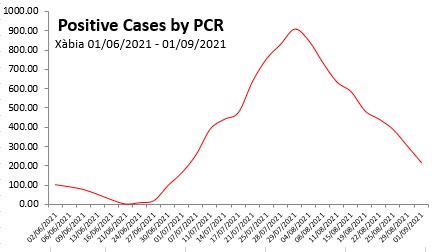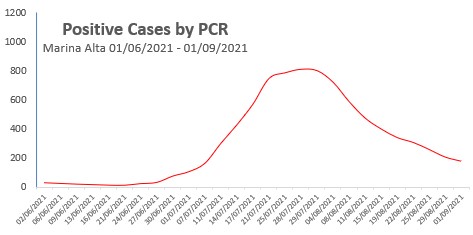VIRUS UPDATE: Positive cases in Xàbia climb by just 7, the lowest rise since late June
Only one health department in the Comunidad Valencian remains in the Extreme Risk level.

Friday 3rd September 2021 – Compiled by MIKE SMITH
Xàbia
The total number of positive coronavirus cases detected by PCR test in Xàbia has climbed to 2,300, according to the latest update from the regional health ministry, an increase of 7 since the last update on Tuesday 31st August.
The municipality’s 14-day IA rate, a measure of the speed at which the virus moves through the population, has dropped to 217.73 cases per 100,000 inhabitants and the town remains in the ‘Extreme Risk’ alert level.

There have been no new deaths in Xàbia since late March and the number remains at 12.
Marina Alta
There have been 307 new positive cases detected by PCR test in the Marina Alta in the past 14 days and the region’s 14-day IA rate has dropped to 179.93 cases per 100,000 inhabitants and it remains in the ‘High Risk’ alert level. The detection of positive cases of COVID-19 in the region has almost halved in two weeks.

There has been 1 new deaths since the last update – in Dénia – and the region’s toll rises to 206.
The total number of positive cases since the pandemic began is now 14,415 since the last update on Tuesday 31st August, a rise of 65.
- 15 – Teulada-Moraira
- 14 – Calp; Dénia
- 7 – Xàbia
- 4 – Ondara; Pego
- 3 – Benissa
- 2 – Pedreguer
- 1 – Beniarbeig; El Vergel
Municipalities at EXTREME RISK level
El Vergel; Teulada-Moraira; Tormos.
Municipalities at HIGH RISK level
Benissa; Calp; Dénia, Xàbia.
Municipalities at MEDIUM RISK level
Gata de Gorgos; Ondara; Orba; Pedreguer; Pego; el Poble Nou de Benitatxell.
Municipalities at LOW RISK level
Beniarbeig.
Autonomous Regions at NEW NORMAL level
Adsubia; Alcalalí; Benidoleig; Benigembla; Benimeli; Castell de Castells; Els Poblets; Llíber; Murla; Parcent; el Ràfol d’Almúnia; Sagra; Sanet y Negrals; Senija; la Vall d’Ebo; la Vall de Lagaur; la Vall de Gallinera, Xaló.
Spain
Spain’s 14-day IA rate is 210.62 cases per 100,000 inhabitants, a drop of almost 42% in the last week, and which means that the country remains the High Risk level.
The Positivity Rate, the measure of how many coronavirus tests return positive, has dropped to 8.58%. A value of 5% or less indicates that transmission of the virus is more or less under control.

Hospitalizations
According to the latest report from the CCAES, there are 6,288 hospitalized due to COVID-19 across Spain, a drop of over 26% on two weeks ago, of which 1,491 have been admitted to ICU wards, a drop of over 19% on two weeks ago. The percentage of beds in general wards occupied by patients suffering from COVID-19 is 5.34% whilst the percentage of beds in ICU wards occupied by COVID-19 patients is 16.29%, both lower than two weeks ago.

Madrid still leads the way in hospitalizations with 1,366 people currently in hospital due to COVID-19, of which 30.18% have been admitted to ICU wards for extreme cases. Cataluña is just behind, with 1,293 people in hospital, of which 29.13% are in ICU wards, whilst Andalucia has 867 people in hospital, 10.11% of which are being cared for in ICU wards.
In the Comunidad Valenciana, 388 people are currently hospitalized, according to the latest CCAES report, with 12.87% of ICU ward capacity occupied by those suffering from the extreme effects of COVID-19.
Deaths
The country has suffered 360 deaths in the past seven days, a rise of just over 10% when compared to two weeks ago. This appears to be the normal progress of the infection spread: positive cases rise, then hospitalizations increase, and finally the number of deaths increase. This can clearly been seen in the three charts given in this summary for Spain.
The national death toll rises to 84,640 since the pandemic began.

Regional Data
Across Spain, the rise of infections continues to slow with all but one of the 19 autonomous regions have reported IA rates lower than they were two weeks ago, the North African autonomous city region of Melilla (438.70) being the odd one out with a 24% increase compared to two weeks ago.
Behind Melilla, just two regions remains above 400: the autonomous city of Ceuta (419.23) and Extremadura (413.07).
At the other end of the scale remains Asturias (86.18) with the Canarias on 130.79.
The Comunidad Valenciana’s rate, currently 163.88, has dropped by 52% in the past two weeks and it remains the autonomous region with the second lowest rate in mainland Spain behind Asturias. All health departments in the region has seen positives cases drop over the past two weeks and on average, infection spread has decreased by 45% in the past fortnight.
Autonomous Regions at EXTREME RISK level
Baleares; Cantabria; Castilla-La Mancha; Ceuta; Extremadura; La Rioja; Melilla; País Vasco.
Autonomous Regions at HIGH RISK level
Andalucia; Aragón; Castilla y León; Cataluña; Comunidad Valenciana; Galicia; Madrid; Murcía; Navarra.
Autonomous Regions at MEDIUM RISK level
Asturias; Canarias.
Autonomous Regions at LOW RISK level
None
Autonomous Regions at NEW NORMAL level
None
The newspaper El Pais has reported that the Spanish tourism industry has experienced an unexpected boost during the summer, thanks to the large number of domestic tourists travelling across the country, far more than in 2019. “The summer has been very good. We have hotels that have even done better than in August 2019,” says Antonio Catalón, the president of AC Hotels by Marriott. Fears of the impact of the Delta variant of the coronavirus, which led to the UK, Germany and France recommending against travel to Spain, was largely eased by the strong progress of the country’s vaccination drive, with 70% of the population now fully vaccinated. However, the industry acknowledges that it needs to win back foreign tourists, who are key to the success of the tourism sector in Spain.
How does Spain compare to the rest of Europe?
Top 20 table based on new confirmed COVID-19 cases per 1 million population on September 2nd 2021.
- Montenegro (917.35) ↓
- Kosovo (845.57) ↓
- United Kingdom (492.20) ↓
- Serbia (391.67) ↑
- North Macedonia (377.40) ↓
- Albania (296.81) ↓
- Cyprus (295.04) ↓
- Switzerland (290.04) ↑
- Greece (276.37) ↓
- Estonia (269.07) ↑
- Norway (256.93) ↑
- Slovenia (238.95) ↑
- Republic of Ireland 238.93) ↓
- Lithuania (225.34) ↑
- France (221.04) ↓
- Bulgaria (219.98) ↓
- Turkey (199.87) ↓
- Portugal (195.31) ↑
- Iceland (195.13) ↓
- Monaco (180.74) –
Spain is in the 27th position (150.13) ↑
↑ = infection spread trend rising
↓ = infection spread trend dropping
Source: ourworldindata.org
Vaccination (02.09.21)
Spain has administered 66,464,730 doses of vaccine, which is 89.9% of those which it has already received (73,950,982). A total of 33,657,941 people have completed the recommended course, which is 79.2% of the total of the population which is to be vaccinated (42,119,827) or 70.3% of the total population of Spain.
According to the latest data provided by the health authorities, 94.3% of people aged 40 and over in Spain have received at least one dose, with 92.2% having completed the recommended course.
The Comunidad Valenciana has administered 7,147,233 doses of vaccine, which is 90.9% of the total which it has received (7,860,390). A total of 3,613,566 people have completed the recommended course, which 79.2% of the population which is to be vaccinated (4,488,459) or 70.3% of the total population of the Comunidad Valenciana.
According to the latest data provided by the health authorities, 94.9% of people aged 40 and over in the Comunidad Valenciana have received at least one dose, with 92.8% having completed the recommended course.
How does Spain compare to the rest of Europe?
Top 20 table based on percentage of total population fully vaccinated.
- Malta (80.22%)
- Iceland (76.82%)
- Portugal (75.01%)
- Denmark (72.44%)
- Spain (71.40%)
- San Marino (70.44%)
- Belgium (69.90%)
- Republic of Ireland (67.84%)
- United Kingdom (62.91%)
- Netherlands (62.32%)
- Italy (61.04%)
- Germany (60.11%)
- France (59.76%)
- Cyprus (58.85%)
- Austria (57.65%)
- Sweden (56.97%)
- Norway (56.49%)
- Lithuania (56.32%)
- Luxembourg (56.10%)
- Monaco (55.55%)
Source: ourworldindata.org
LINKS
- Actualización nº 454. Enfermedad por el coronavirus (COVID-19). 02.09.2021
- GIV COVID-19 Gestión integral de la vacunación COVID-19
- COVID-19 C. Valenciana: Monitoratge de la situació




